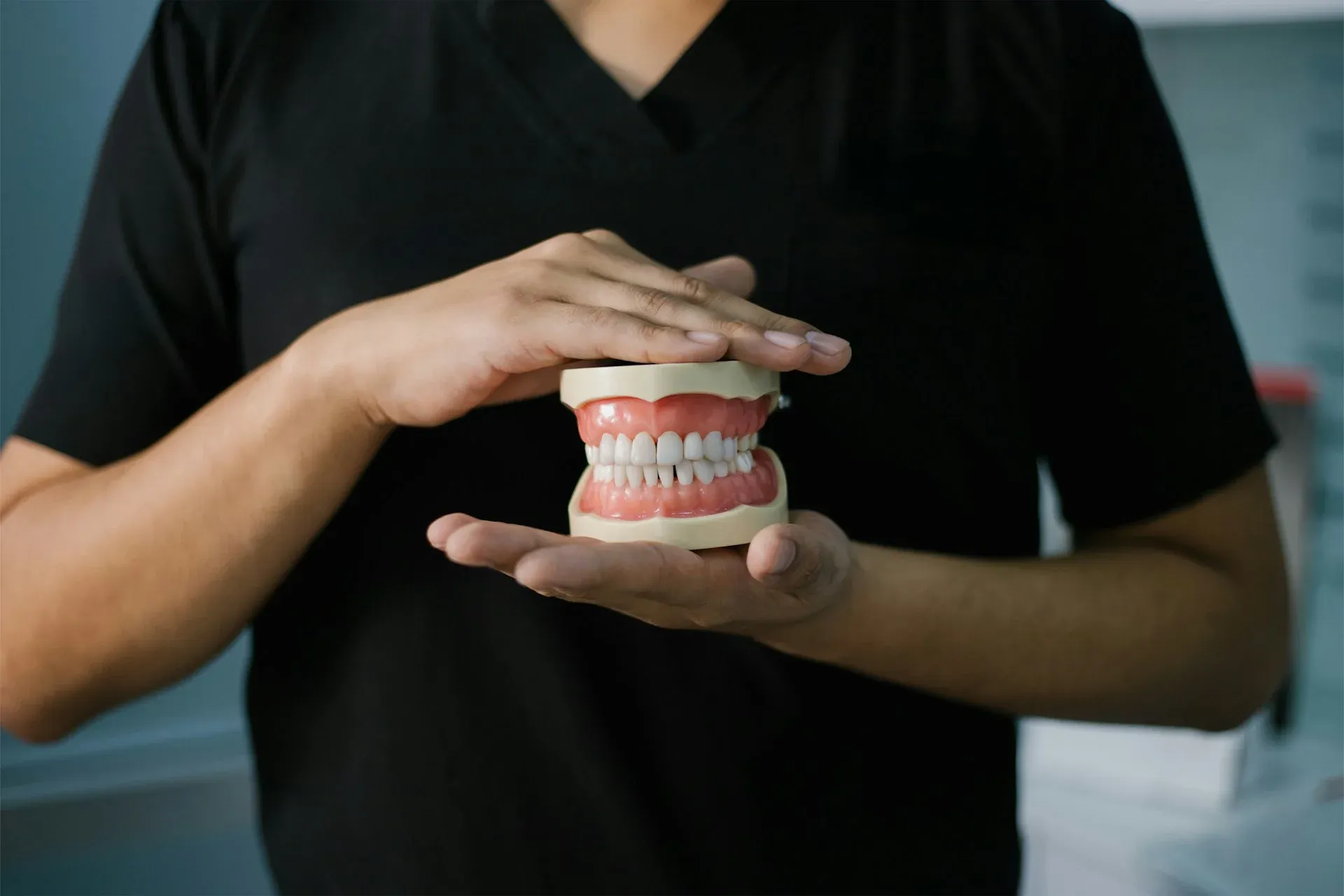Doctor certified article
Dental Bonding vs. Veneers: How to Choose the Best Option for Your Smile

You want that perfect, aesthetically beautiful smile but are stuck between dental bonding and veneers. You’re trying but the overwhelming amount of information on the internet, well, overwhelms you.
What if you pick the wrong one? What if bonding doesn’t last as long as you hoped? Or veneers look unnatural? You’re afraid the wrong choice can cost you a lot and you’re someone who triple-checks the menu before ordering, just to make sure you won’t regret your choice.
We understand where you’re coming from.
In this guide, we’ll cut through the confusion and give you a clear, no-fluff comparison of dental bonding vs. veneers and help you understand which option is best for you.
Let’s start. Shall we?
Understanding Dental Bonding
We’d recommend dental bonding if you have minor imperfections in your teeth. It’s simple, painless and affordable compared to other options.
Let’s take a look in detail.
What is dental bonding?
Dental bonding is a cosmetic procedure where a tooth-colored resin is applied and hardened with a special light to repair chipped, discolored, or misshapen teeth.
You can repair several teeth in a single visit and have resin be color-matched with your teeth color. The procedure is simple, non-invasive, and safe, and can correct many imperfections at a time, including gaps and tooth coloring.
Also, did we mention that dental bonding is a reversible process and is a budget-friendly alternative to veneers or crowns?
Procedure Breakdown of Dental Bonding
The procedure is simple, pain-free and quick. Let’s look at how dental bonding is done.
- Tooth Preparation
Your dentist selects a composite resin shade that matches your natural teeth.
- Application of Resin
The dentist then roughens the surface of your tooth and applies the conditioning liquid to help the resin adhere.
- Shaping and hardening the tooth
It’s time to mold the resin into the desired shape and harden it using a special curing light to ‘bond’ the material to your tooth surface.
- Final Touches
Finally, the dentist trims and polishes the material to ensure it blends with your natural teeth.
Note that it only takes 30 to 60 minutes per tooth and you won’t be given any anesthesia during the procedure (as it’s pain-free).
When is dental bonding recommended?
Dental bonding is recommended when you want to:
- Camouflage tooth discoloration.
- Change the shape of your tooth.
- Conceal chips/cracks in your tooth.
- Make your teeth look longer.
- Close spaces between your teeth.
In other words, if your concerns are purely cosmetic or minor, binding is the easiest and quickest solution.
Pros & Cons of Dental Bonding
Let’s look at the advantages and disadvantages of dental bonding:
Advantages of Dental Bonding
- Budget-friendly
Dental bonding is one of the cheapest ways to fix minor tooth imperfections.
While veneers can cost you anywhere from $1300 to $2500 per tooth, bonding only costs around $250 to $600.
It’s also minimally invasive, so costly prep work like enamel removal or lab made restorations are not required.
- Quick and Painless
Luckily, dental bonding is a one-and-done procedure that is completed within 30 to 60 minutes per tooth.
No drilling or needles required. You walk into your dentist’s office with damaged teeth and walk out with a fresh, confident smile.
- Minimally Invasive (No Enamel Removed)
Bonding is not a permanent attachment to your teeth. Guess what this means?
- No irreversible changes to your tooth structure.
- No pain or sensitivity afterwards
- Opportunity to consider other procedures later.
Disadvantages of Dental Bonding
- Not as Durable as Veneers or Crowns
Bonding is made of composite material and is prone to chipping and breaking, especially if you bite your nails or chew on pens and pencils.
If you’re looking for durable options, bonding is not the best solution.
- Can Stain Over Time
Bonding material can absorb stains from coffee, red wine, and smoking over time. If you drink a lot of staining beverages, be prepared to notice yellowing or discoloration after a few years.
You don’t want to limit your favorite foods. Do you?
- May Require Touch-Ups or Replacements
Bonding isn’t as strong as other options, which explains why it requires periodic repairs.
If it chips, wears down, or starts looking stained, you might want a full replacement much sooner than you’d want.
Understanding Veneers
We’d recommend veneers if you’re looking for a long-lasting solution to enhance your smile. They’re durable, natural-looking, and perfect for covering gaps.
Let’s take a look in detail.
What are Veneers?
Veneers are thin, custom-made shells of porcelain or composite resin that cover the front surface of your teeth to improve their appearance. They help correct discoloration, chips, gaps, and misshapen teeth.
The procedure involves removing a small amount of your tooth enamel to help accommodate the veneers and choosing a color that best matches your smile.
Procedure Breakdown of Dental Veneers
You might require a few extra visits to the dentist, but the procedure isn’t complicated.
- Consultation & Smile Assessment
The first thing your dentist would do is to evaluate whether veneers are the right fit for you.
This involves:
- A thorough oral examination to check for cavities, gum disease, or other underlying issues.
- Taking x-rays to assess your tooth structure
If you have missing teeth, gum disease, or cavities, the dentist would recommend alternative options to ensure you get the right treatment.
- Tooth Preparation & Enamel Removal
Now that you’re approved for veneers, it's time to prep your teeth.
Your dentist will remove enamel from the front surface of each tooth to make room for veneers to fit.
However, you’ll also find a low-prep veneer option that requires little to no enamel removal.
- Taking Impressions & Choosing the Shade
Your dentist will take impressions of your prepped teeth to create custom veneers.
You’ll work with the dentist to select the perfect shade that matches your teeth. The impressions are then sent to the dental lab for veneer preparation.
It usually takes 1-2 weeks to prepare these veneers. In the meantime, you’ll be provided with temporary veneers to protect your teeth.
- Veneer Fitting & Bonding Process
You return to your dentist once your veneers are ready.
The temporary veneers are removed and the porcelain veneers are placed on the tooth. If you feel satisfied with the results, the dentist will polish your teeth and make minor changes to ensure your new smile is perfect.
When are Veneers recommended?
Dentists recommend veneers when you want:
- Long-lasting, stain-resistant whitening.
- A durable solution for chipped or cracked teeth.
- To correct uneven shapes and small gaps.
Pros & Cons of Veneers
Let’s look at the advantages and disadvantages of veneers.
Advantages of Veneers
- Long-Lasting & Durable
Porcelain veneers can last up to 10-20 years with proper care. They’re a lot stronger than dental bonding and can withstand daily wear and tear.
- Highly Stain-Resistant
Veneers are resistant to changes over time. They can resist stains such as those from pigmented beverages like wine and coffee and even smoking.
- Minimal Upkeep
Veneers don’t require special maintenance. Stick to your regular brushing, flossing and checkups and you’ll see they don’t even develop cavities.
Disadvantages of Veneers
- High Cost
Veneers can range from $1300 to $2500 per tooth, making them an expensive cosmetic dental treatment. Patients usually consider twice before investing in them.
- Irreversible Procedure
A thin layer of enamel is removed to fit veneers, so the procedure is permanent, considering enamel doesn’t grow back. This means that you’ll always need veneers or another restoration for life. No changing of mind once you’re in.
- Longer Treatment Process
While bonding is done in a single visit, veneers require multiple appointments, for preparation and placement.
- Risk of Sensitivity
Some patients have reported experiencing increased tooth sensitivity to hot and cold. Luckily, it fades over time.
Key Differences: Dental Bonding vs. Veneers
There are a lot of major differences between the 2 procedures. However, don’t forget to connect to experts if you need help.
Back to the discussion.
- Longevity & Strength
Veneers can last 10-20 years and are more resistant to chipping and cracking. On the other hand, dental bonding lasts 3-10 years and is more prone to chipping or wearing down over time.
- Aesthetic Differences
While both procedures offer natural-looking results, veneers come fully customized in shape, size, and shade, offering a precise and natural appearance.
Dental bonding, while color matched to your teeth, might not offer the same level of customization in shape and translucency.
- Ideal Use Cases
Veneers are suitable when you want significant cosmetic changes, such as severe discoloration, large gaps, or major reshaping.
However, dental bonding is suitable for minor fixes, like small chips, slight discoloration, or minor reshaping.
- Time & Invasiveness
Teeth bonding is one of the fastest and most convenient options for people with tight schedules, or who want quick results.
The process takes 30-60 minutes per tooth and you get things done in a single visit.
On the other hand, veneers may require additional visits for impression taking, tooth preparation and veneer fitting.
Which is Better, Veneers or Bonding?
What should be an ideal treatment for your teeth depends on your needs, budget, and long-term expectations.
Let’s make it simple for you to decide:
Choose dental bonding if:
- You have minor cosmetic issues like small chips, slight discoloration, or minimal gaps.
- You’re looking for an affordable, quick-fix solution that doesn’t require enamel removal.
- You want a reversible option with minimal commitment.
Choose veneers if:
- You need a long-lasting, durable solution for severe discoloration, larger gaps, or significant reshaping.
- You want a more stain-resistant option that maintains its color over time.
- You’re comfortable with an irreversible procedure and a higher upfront investment.
Alternative Cosmetic Dentistry Options
We know you were indecisive between bonding and veneers. While they are excellent cosmetic treatments, they’re not ideal for every dental problem.
Here are a few options that could better serve you:
- Teeth Whitening
Teeth whitening is the simplest, least invasive and most effective treatment if your only concern is stained or discolored teeth. The problem starts when your teeth are deeply stained. Now, teeth whitening can’t help and you’ll have to consider veneers.
- Dental Crowns
Dental crown is a superior choice if your tooth is badly broken, weakened, or has a significant decay. The reason behind this is that veneers and bonding are cosmetic fixes and for conditions as severe as this, you need a crown to provide full-coverage protection and restore functionality.
- Orthodontics
Orthodontic treatments like braces or clear aligners (e.g., Invisalign) have to be the most effective solution for crooked teeth, misalignment, or large gaps. I’m not saying veneers are bad.
But while they can improve the appearance of mild alignment, there are underlying structural issues that can only be fixed by orthodontic treatments.
Still unsure which option to choose? Know that there’s a way out
We understand it can get hard to make the decision. But when in doubt, your first call should be to contact a licensed cosmetic dentist to discuss the best option based on your health, preferences and budget.
We recommend you check out Quality Care Global if you’re looking for professional help. They can help you connect with the best dentists from around the globe so you get the best possible treatment without the stress of endless research (and confusion).
With the right professionals by your side, you’ll make decisions that feel right for years to come. No more second-guessing, no more regrets. Check us out today.

